(1,5-Cyclooctadiene)rhodium chloride dimer

(1,5-Cyclooctadiene)rhodium chloride dimer structure
|
Common Name | (1,5-Cyclooctadiene)rhodium chloride dimer | ||
|---|---|---|---|---|
| CAS Number | 12092-47-6 | Molecular Weight | 493.079 | |
| Density | N/A | Boiling Point | 153.5ºC at 760mmHg | |
| Molecular Formula | C16H24Cl2Rh2 | Melting Point | 255ºC (dec.) | |
| MSDS | Chinese USA | Flash Point | 31.7ºC | |
| Symbol |

GHS07 |
Signal Word | Warning | |
| Name | Chloro(1,5-cyclooctadiene)rhodium(I) dimer |
|---|---|
| Synonym | More Synonyms |
| Boiling Point | 153.5ºC at 760mmHg |
|---|---|
| Melting Point | 255ºC (dec.) |
| Molecular Formula | C16H24Cl2Rh2 |
| Molecular Weight | 493.079 |
| Flash Point | 31.7ºC |
| Exact Mass | 491.936523 |
| Storage condition | 2-8°C |
| Stability | hygroscopic |
| Water Solubility | Soluble in chloroform, dichloromethane, and methanol. Sparingly soluble in most common solvents. |
Synonym:Di-mu.-chlorobis[1,2,5,6-n)-1,5-cyclooctadiene] dirhodiu Section 2 - COMPOSITION, INFORMATION ON INGREDIENTS
Risk Phrases: None Listed. Section 3 - HAZARDS IDENTIFICATION EMERGENCY OVERVIEW
The toxicological properties of this material have not been fully investigated. Potential Health Effects Eye: May cause eye irritation. Skin: May cause skin irritation. Ingestion: May cause irritation of the digestive tract. The toxicological properties of this substance have not been fully investigated. Inhalation: May cause respiratory tract irritation. The toxicological properties of this substance have not been fully investigated. Chronic: No information found. Section 4 - FIRST AID MEASURES Eyes: Flush eyes with plenty of water for at least 15 minutes, occasionally lifting the upper and lower eyelids. Get medical aid immediately. Skin: Get medical aid. Flush skin with plenty of water for at least 15 minutes while removing contaminated clothing and shoes. Wash clothing before reuse. Ingestion: If victim is conscious and alert, give 2-4 cupfuls of milk or water. Never give anything by mouth to an unconscious person. Get medical aid immediately. Inhalation: Remove from exposure and move to fresh air immediately. If not breathing, give artificial respiration. If breathing is difficult, give oxygen. Get medical aid. Notes to Physician: Section 5 - FIRE FIGHTING MEASURES General Information: As in any fire, wear a self-contained breathing apparatus in pressure-demand, MSHA/NIOSH (approved or equivalent), and full protective gear. During a fire, irritating and highly toxic gases may be generated by thermal decomposition or combustion. Extinguishing Media: Use agent most appropriate to extinguish fire. Use water spray, dry chemical, carbon dioxide, or appropriate foam. Section 6 - ACCIDENTAL RELEASE MEASURES General Information: Use proper personal protective equipment as indicated in Section 8. Spills/Leaks: Clean up spills immediately, observing precautions in the Protective Equipment section. Sweep up or absorb material, then place into a suitable clean, dry, closed container for disposal. Avoid generating dusty conditions. Provide ventilation. Section 7 - HANDLING and STORAGE Handling: Wash thoroughly after handling. Remove contaminated clothing and wash before reuse. Use with adequate ventilation. Minimize dust generation and accumulation. Avoid contact with eyes, skin, and clothing. Keep container tightly closed. Avoid ingestion and inhalation. Storage: Store in a tightly closed container. Store in a cool, dry, well-ventilated area away from incompatible substances. Section 8 - EXPOSURE CONTROLS, PERSONAL PROTECTION Engineering Controls: Facilities storing or utilizing this material should be equipped with an eyewash facility and a safety shower. Use adequate ventilation to keep airborne concentrations low. Exposure Limits CAS# 12092-47-6: United Kingdom, WEL - TWA: (listed as rhodium): 0.1 mg/m3 TWA (du and fume) United Kingdom, WEL - STEL: (listed as rhodium): 0.3 mg/m3 STEL ( and fume) United States OSHA: 0.1 mg/m3 TWA (listed under Rhodium).0.001 m TWA (as Rh) (listed under Rhodium soluble compounds). Belgium - TWA: (listed as rhodium soluble compounds): 0.01 mg/m3 (as Rh) France - VME: (listed as rhodium): 1 mg/m3 VME Germany: (listed as rhodium): 1 mg/m3 VME Malaysia: (listed as rhodium soluble compounds): 0.01 mg/m3 TWA ( Rh) Netherlands: (listed as rhodium soluble compounds): 0.001 mg/m3 M (as Rh) Spain: (listed as rhodium soluble compounds): 0.01 mg/m3 VLA-ED ( Rh) Personal Protective Equipment Eyes: Wear appropriate protective eyeglasses or chemical safety goggles as described by OSHA's eye and face protection regulations in 29 CFR 1910.133 or European Standard EN166. Skin: Wear appropriate protective gloves to prevent skin exposure. Clothing: Wear appropriate protective clothing to prevent skin exposure. Respirators: A respiratory protection program that meets OSHA's 29 CFR 1910.134 and ANSI Z88.2 requirements or European Standard EN 149 must be followed whenever workplace conditions warrant respirator use. Section 9 - PHYSICAL AND CHEMICAL PROPERTIES Physical State: Crystalline powder Color: Yellow-Orange Crystalline Powder Odor: Not available. pH: Not available. Vapor Pressure: Not available. Viscosity: Not available. Boiling Point: Not available. Freezing/Melting Point: 243 deg C Autoignition Temperature: Not available. Flash Point: Not available. Explosion Limits, lower: Not available. Explosion Limits, upper: Not available. Decomposition Temperature: Solubility in water: Specific Gravity/Density: Molecular Formula: C16H24Cl2Rh2 Molecular Weight: 493.08 Section 10 - STABILITY AND REACTIVITY Chemical Stability: Stable under normal temperatures and pressures. Conditions to Avoid: Incompatible materials, dust generation, strong oxidants. Incompatibilities with Other Materials: Strong oxidizing agents. Hazardous Decomposition Products: Hydrogen chloride, carbon monoxide, carbon dioxide. Hazardous Polymerization: Has not been reported Section 11 - TOXICOLOGICAL INFORMATION RTECS#: CAS# 12092-47-6 unlisted. LD50/LC50: Not available. Carcinogenicity: Chloro-(1,5-cyclooctadiene)-rhodium (I) dimer - Not listed by ACGIH, IARC, or NTP. Section 12 - ECOLOGICAL INFORMATION Section 13 - DISPOSAL CONSIDERATIONS Dispose of in a manner consistent with federal, state, and local regulations. Section 14 - TRANSPORT INFORMATION IATA Not regulated as a hazardous material. IMO Not regulated as a hazardous material. RID/ADR Not regulated as a hazardous material. Section 15 - REGULATORY INFORMATION European/International Regulations European Labeling in Accordance with EC Directives Hazard Symbols: Not available. Risk Phrases: Safety Phrases: S 24/25 Avoid contact with skin and eyes. S 28A After contact with skin, wash immediately with plenty of water. S 37 Wear suitable gloves. S 45 In case of accident or if you feel unwell, seek medical advice immediately (show the label where possible). WGK (Water Danger/Protection) CAS# 12092-47-6: 0 Canada CAS# 12092-47-6 is listed on Canada's NDSL List. CAS# 12092-47-6 is not listed on Canada's Ingredient Disclosure List. US FEDERAL TSCA CAS# 12092-47-6 is listed on the TSCA inventory. SECTION 16 - ADDITIONAL INFORMATION N/A |
| Symbol |

GHS07 |
|---|---|
| Signal Word | Warning |
| Hazard Statements | H315-H319-H335 |
| Precautionary Statements | P261-P305 + P351 + P338 |
| Personal Protective Equipment | dust mask type N95 (US);Eyeshields;Gloves |
| Hazard Codes | Xi:Irritant; |
| Risk Phrases | R36/37/38 |
| Safety Phrases | S26-S37/39 |
| RIDADR | NONH for all modes of transport |
| WGK Germany | 3 |
| Precursor 8 | |
|---|---|
| DownStream 9 | |
|
The use of a [4 + 2] cycloaddition reaction for the preparation of a series of 'tethered' Ru(II)-diamine and aminoalcohol complexes.
Org. Biomol. Chem. 5 , 1093, (2007) A series of catalysts have been prepared for use in the asymmetric transfer hydrogenation of ketones. The complexes were prepared using a [4 + 2] cycloaddition reaction at a key step in the reaction s... |
|
|
Pure Appl. Chem. 66 , 1509, (1994)
|
|
|
Tetrahedron Asymmetry 4 , 2279, (1993)
|
| Bis(1,5-cyclooctadiene)dirhodium(I) Dichloride |
| (1Z,5Z)-cycloocta-1,5-diene,rhodium,dichloride |
| (1,5-Cyclooctadiene)rhodium chloride dimer |
| MFCD00012415 |
| 1,5-Cyclooctadiene - chlororhodium (1:1) |
| 1,5-Cyclooctadiene Rhodium(I) Chloride Dimer |
| EINECS 235-157-6 |
| Chloro(1,5-Cyclooctadiene)Rhodium(I) Dimer |
| (1Z,5Z)-Cycloocta-1,5-diene - chlororhodium (1:1) |
| Chloro(1,5-cyclooctadiene)rhodium(I)dimer |
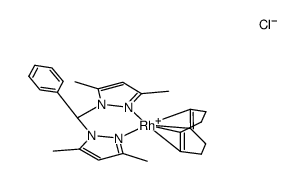 CAS#:80319-87-5
CAS#:80319-87-5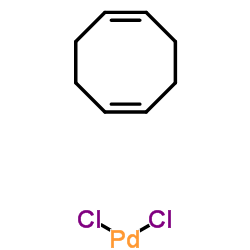 CAS#:12107-56-1
CAS#:12107-56-1 CAS#:115338-66-4
CAS#:115338-66-4 CAS#:26042-63-7
CAS#:26042-63-7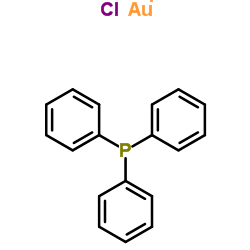 CAS#:14243-64-2
CAS#:14243-64-2![cis-[PdCl2(CN(t-Bu))2] Structure](https://image.chemsrc.com/caspic/290/34710-33-3.png) CAS#:34710-33-3
CAS#:34710-33-3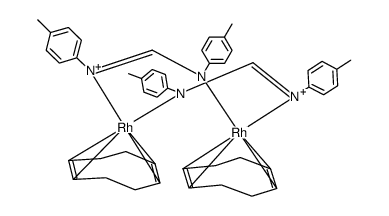 CAS#:81229-43-8
CAS#:81229-43-8 CAS#:124225-83-8
CAS#:124225-83-8 CAS#:108559-48-4
CAS#:108559-48-4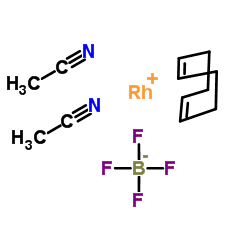 CAS#:32679-02-0
CAS#:32679-02-0![2,2'-[1,2-Phenylenebis(oxy)]bis(1,3,2-benzodioxaborole) structure](https://image.chemsrc.com/caspic/030/37737-62-5.png) CAS#:37737-62-5
CAS#:37737-62-5 CAS#:2049-55-0
CAS#:2049-55-0 CAS#:33409-86-8
CAS#:33409-86-8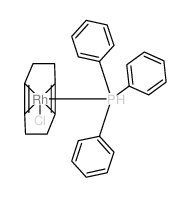 CAS#:31781-57-4
CAS#:31781-57-4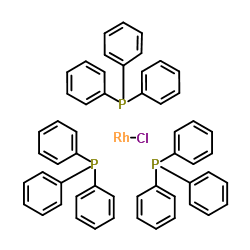 CAS#:14694-95-2
CAS#:14694-95-2![Rhodium, [bis[3- (diphenylphosphino)propyl]phenylphosphine-P,P, P]chloro-, (SP-4-3)- structure](https://image.chemsrc.com/caspic/306/34964-03-9.png) CAS#:34964-03-9
CAS#:34964-03-9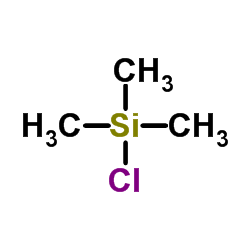 CAS#:75-77-4
CAS#:75-77-4
